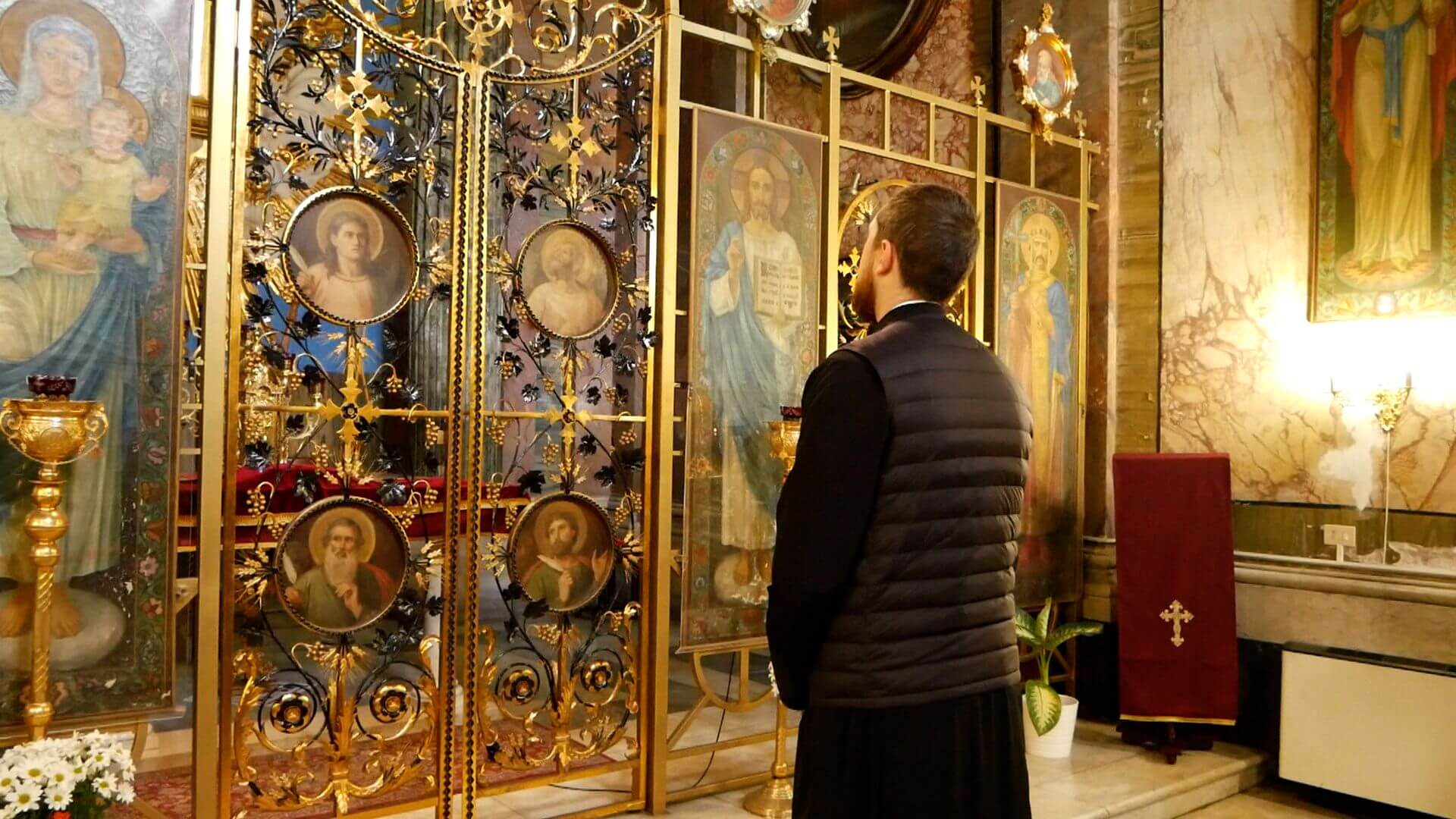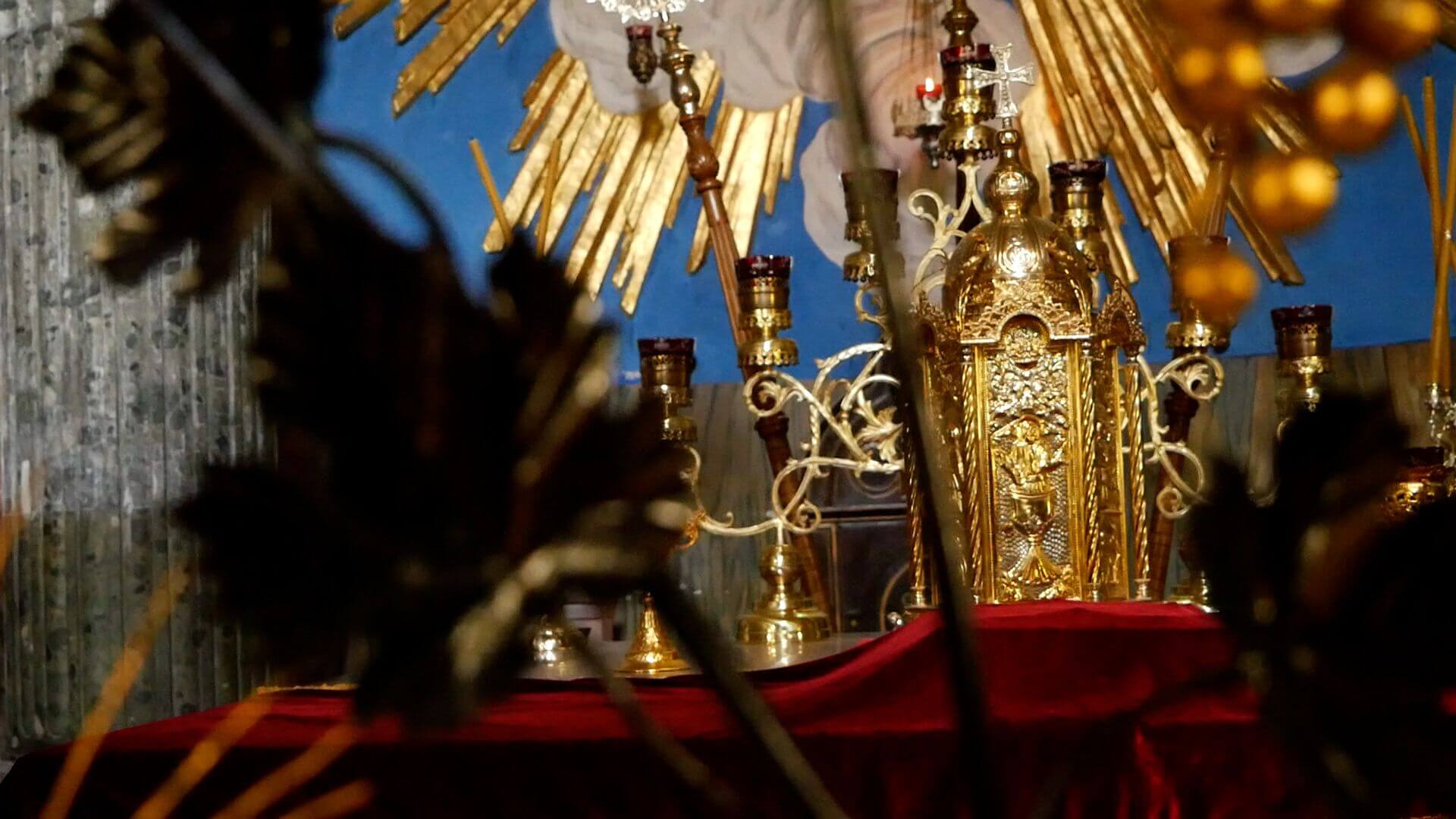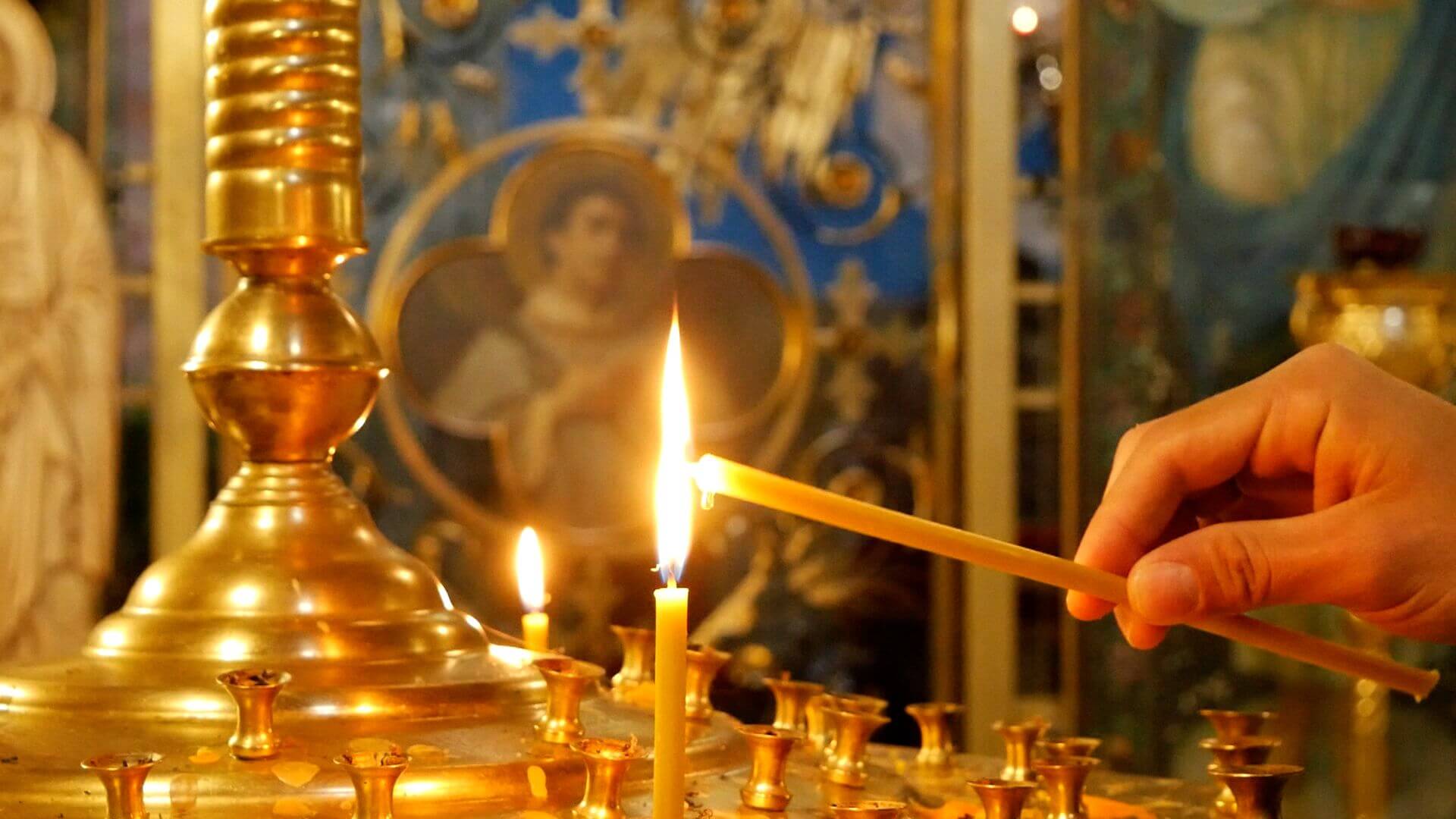An interview with the Pastor of the Ukrainian Catholic Church in Rome.
From One Peter Five
By Vincenzo Randazzo
Interview with Fr. Taras Ostafiiv
Pastor of the Church of Saints Sergius and Bacchus of the Ukrainians
Tuesday, March 15, 2022 Rome, Italy
Vincenzo Randazzo: Father, Can you tell us something about your vocation? How did you get here to Rome?
Father Taras Ostafiiv: I was born in Ukraine, as a child I felt this vocation that I would like to become a priest and I had a good example from my parish priest. And then, at the end of school, I felt this vocation even stronger. I decided to study, to go to the seminary, to study to become a priest. And then, when I was in the seminary, in 2013, just in the last year I decided to become an “unmarried” priest because in our country usually all priests are married. So I decided to become a celibate priest and I was ordained in 2013, after which I came here to Rome to continue my studies, deepen my research. I did two years of studies in the Pontifical Accademia Alfonsiana, I studied moral theology with a focus on bioethics. After that I was appointed vice-parish priest in this parish here. The previous pastor was elected as the bishop in a diocese in Ukraine, he left for Ukraine and so I replaced him. I became pastor in 2019 and since then I am pastor here.
VR: Can you tell us about this parish?
FTO: So this Church here is the very ancient Church and the oldest Ukrainian Church outside the Ukrainian territory. It was regulated by the popes, in particular by Pope Urban VIII to the metropolitans of Kiev in 1638, after the metropolitans restored the unity of the Church of Kiev with the Bishop of Rome. Before they were under the jurisdiction of the Patriarch of Constantinople. At that time the churches were already divided. Let’s say that the division existed for what in modern terms we can say “Catholics and Orthodox” but at that time those terms were not necessarily used. At that time there were Catholics, with the supreme authority of the Roman Pontiff, and then there were the Orthodox with those four ancient patriarchs and the metropolitan of Kiev was under the jurisdiction of the Patriarch of Constantinople. But the metropolitans of Kiev wanted to restore unity with the Church of the first millennium and therefore, they came out from under the jurisdiction of the Patriarch of Constantinople. They signed a pact, a union with the Bishop of Rome and from there, since 1596, the Kiev Metropolitan Church again retained its unity with the Catholic Church, the universal Church. After that the metropolitans were looking for a place in Rome to have a representative of the Kiev Church at the Holy See. And Pope Urban VIII gave this Church to the Kiev Metropolitans. Since 1638 until now the Church belongs to the Ukrainian Church.
What is the Ukrainian community like here in Rome, and Ukrainian Catholics at this parish?
In the 90s, around 1996, there were very few Ukrainians in Rome, two, four people, not more. After the fall of the Soviet Union, when the borders opened, many Ukrainians were able to leave. They started to look for work outside the territory of Ukraine and here came mostly women to be caregivers and cleaners. From 1996, slowly until the beginning of 2000, many Ukrainians continued to arrive here in Rome. Here in Rome there are about 15,000 Ukrainians, mostly women. I would say it’s eighty-five or ninety percent women here. Our community is ninety percent women. Sunday Mass. All three Sunday masses are attended more or less by 150 to 200 people. And here we are in the center of Rome, so the Church is very easily reachable by transport, so women can attend this church here even on weekdays. Most work so they cannot participate in the celebrations in this church every day. Our best attended liturgies are Thursday afternoon and Sunday.
There are two other places of our rite, the Santa Sofia a Via Boccea and the Monastery of the Basilian Fathers on the Aventine.
Can it be said that this is the primary Ukrainian Catholic Church in Rome?
This is the only personal parish for Ukrainians in Rome. It was established this way in 1971, when Patriarch Josyf Slipyj was freed from Siberia, from the gulag, thanks to President Kennedy, and Pope John XXIII who begged Khrushchev to free him from Siberia. He was released from the Soviet Union without permission to return to the country ever again. So when he came to Rome after eighteen years in the gulag, he wanted to establish a parish for the Ukrainians. Here in Rome this church was chosen as the parish church. A personal national parish was created for the Ukrainian Catholics of Byzantine rite who live on the territory of the diocese of Rome. This church has functioned as a parish since that time.
What is the Ukrainian Byzantine Rite? A Ukrainian Byzantine Catholic?
In the Catholic Church there are many rites. Rite means a way of prayer. Then there are many rites: the Byzantine rite, the Armenian rite, the Syro-Malabar rite, the Syro-Malankar rite, the Maronite rite. The best known rites are the Latin rite, used by the Church of Rome, and the Byzantine rite, the one that most Orthodox Christians use.
Then there are the Byzantine Rite Catholic churches – like ours. There is the Byzantine Rite Catholic Church, Ukrainian, Romanian Byzantine Rite Catholic Church, Melkite Byzantine Rite Catholic Church from Lebanon. There are many churches that do the Byzantine rite. The Byzantine rite is the same for the Orthodox and the Catholics of this rite. There are no differences.
The liturgy, the holy mass in the Byzantine rite is a little bit different from the Latin mass. The clothes and vestments of the priest, for example, are different. The way we make the Sign of the Cross is different, we do it with three fingers. Also the priest, during the liturgy, is along with the people, facing the altar (ad orientem).
The (Byzantine) liturgy is always sung. Always. We can say that the main points of each liturgy, whether in the Byzantine rite or the Latin rite, that they coincide. There are the readings from the Holy Scripture in each rite. The main things: reading the Gospel, reading Holy Scripture, then the moment of consecration of bread and wine. Then the moment of communion – these all coincide. Communion is done under two species. The bread that we use for the liturgy is a little different from the host that they use in the Latin rite. For the moment there are no problems in the differences between the rites. They are a little different, but always, always coincide. The main parts, Holy Scripture, communion – the most important things coincide.
Is the language of your liturgy different?
So until the 90’s the official language was Church Slavonic (paleoslavo), one of the four traditional sacred languages of the church. So in the Church of the Roman Rite the Latin language, in our tradition was the Paleo-Slavic language. But in the 1990s they changed and introduced national languages into the liturgy. So the Byzantine Rite Catholics in Croatia use Croatian, in Serbia-Serbian, in Ukraine-Ukrainian, in Belarus-Belarusian. So they now some of the liturgy is said in the national languages.
How many Ukrainian Catholics are there in Ukraine?
So in Ukraine we are more or less 38 million, of which I would say 4 million are Catholics. The majority of the Catholics, more or less, are Byzantine Rite Catholics. There are some of the Latin rite but the majority of Ukraine are the Orthodox of the Byzantine rite. And there are many other denominations: Protestants, there are Jews, Muslims, the country is multireligious, but most are Christians. Of the various rites Catholics are a minority and Orthodox are the majority.
But, to be clear, never in these years were there religious clashes in the country. We have lived the peaceful inter-religious experience and the churches have a sort of “pan-religious council” we can say. In (said council) in Ukraine all the Christian churches are represented, also the Muslims and the Jews of Ukraine. And that council was always in favor of peace – a peaceful coexistence between all religions that are in Ukraine and to insure that there are no religious wars.
So the relationship between religions in Ukraine peaceful?
Yes yes, without any tension.
How is the parish responding given the current violence in Ukraine?
Since 2014 there has been war in Ukraine. In 2014 Russia took Crimea, invaded that little territory of Donbas. The war started there. It’s not the case that it began these days. Since that time we have been doing what we can to help our country. People help with what they can and give their part: with humanitarian aid, with funds to send to Ukraine. After February 24, when that massive war broke out, the world became very mobilized and even here in Rome we felt it especially – people mobilized to help our country.
They made this initiative to collect basic necessities to send to Ukraine, in the places where now there is disaster, this humanitarian disaster. Also many Romans who live in the area have mobilized and come continuously throughout the day. This Church is open from 6:30 in the morning until 7:00 pm. And every day people call, people get in touch with us, many Italians bring medicine, food – many have made themselves available to accept any refugees from Ukraine. So we have seen here in the Monti neighborhood many Italians are mobilized for, sensitive to, and available to meet the needs that we now have in our home country.
And then there are so many communities that also attend our Church to support us in prayer. Many, many priests, parish priests, bishops who attend our community. Here we had with us the Cardinal Vicar of the Diocese of Rome (Angelo) De Donatis, also (Leonardo) Cardinal Sandri, Prefect of the Congregation for the Oriental Churches, and auxiliary bishops of the Diocese of Rome, many priests, representatives of the different dioceses, of the different associations.
Do you feel supported? Do you feel there is hope?
There is always, always hope. We never lose faith in the Lord. Because we see that the invasion was unjust, the invasion was cruel and the invader is fighting against humanity. It is not only against the Ukrainian people, but against humanity, against the values of humanity, of the civilized world and especially against Christian values. Because the Christian cannot fight against peace, against brotherly love. Whoever does this cannot call himself a Christian. Whoever does so may be unaware, but after they do this they are predestined to fail. We have hope.
Can you tell us a little about the situation in Ukraine for your family?
My family in Ukraine live in the western part of the country where there is no fighting, but many refugees come from the eastern territory. Like everyone in Ukraine they are experiencing a high tension situation because you never know where the danger may come from or some bombing will come. Because the invader not only bombs military facilities, but also hospitals, schools and buildings of ordinary people, civilians. And so everybody during the day hears sometimes one, two, three, four times the alarms that there is danger of bombing and they have to hide in the cellars. In this way they feel the presence of the war also in the territory. But for the moment we can say it is peaceful because there is no fighting in that area.
How can the anglophone Catholic community help?
The whole world is called upon, the whole Catholic world, the Christian world is called upon by the Holy Father Francis to engage in prayers for peace in Ukraine. We don’t have for the moment any other intention except our biggest supplication and invocation to all people of good will, all Christians: to pray to the Lord for peace in Ukraine and the conversion of the enemy. We do not want to kill our invaders, but we want their conversion. If a person converts he understands his mistake, his sin, then he stops it. Then we are happy that he is a converted sinner and now collaborates in spreading brotherly love in the world.
So two intentions we can give: prayer for peace and conversion of the enemy invader.
Thank you, Father Taras, for doing this interview with us
Thank you.
Editor’s note: please consider donating through one of the following Catholic charitable options.
Americans: Follow the options laid out by the Catholic Archeparchy of Philadelphia.
Australians: Donate through Caritas Australia.
Canadians: Donate through the Catholic Near East Welfare Association.
Europeans: Donate through Caritas.
Photo credit: Emma Hinterberger.



No comments:
Post a Comment
Comments are subject to deletion if they are not germane. I have no problem with a bit of colourful language, but blasphemy or depraved profanity will not be allowed. Attacks on the Catholic Faith will not be tolerated. Comments will be deleted that are republican (Yanks! Note the lower case 'r'!), attacks on the legitimacy of Pope Francis as the Vicar of Christ (I know he's a material heretic and a Protector of Perverts, and I definitely want him gone yesterday! However, he is Pope, and I pray for him every day.), the legitimacy of the House of Windsor or of the claims of the Elder Line of the House of France, or attacks on the legitimacy of any of the currently ruling Houses of Europe.